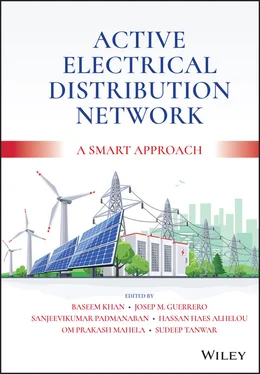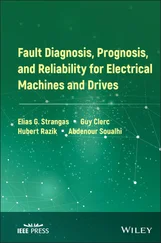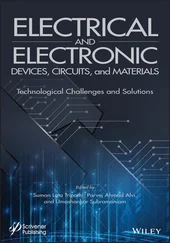Active Electrical Distribution Network
Здесь есть возможность читать онлайн «Active Electrical Distribution Network» — ознакомительный отрывок электронной книги совершенно бесплатно, а после прочтения отрывка купить полную версию. В некоторых случаях можно слушать аудио, скачать через торрент в формате fb2 и присутствует краткое содержание. Жанр: unrecognised, на английском языке. Описание произведения, (предисловие) а так же отзывы посетителей доступны на портале библиотеки ЛибКат.
- Название:Active Electrical Distribution Network
- Автор:
- Жанр:
- Год:неизвестен
- ISBN:нет данных
- Рейтинг книги:5 / 5. Голосов: 1
-
Избранное:Добавить в избранное
- Отзывы:
-
Ваша оценка:
- 100
- 1
- 2
- 3
- 4
- 5
Active Electrical Distribution Network: краткое содержание, описание и аннотация
Предлагаем к чтению аннотацию, описание, краткое содержание или предисловие (зависит от того, что написал сам автор книги «Active Electrical Distribution Network»). Если вы не нашли необходимую информацию о книге — напишите в комментариях, мы постараемся отыскать её.
Discover the major issues, solutions, techniques, and applications of active electrical distribution networks with this edited resource Active Electrical Distribution Network: A Smart Approach
Active Electrical Distribution Network: A Smart Approach
Active Electrical Distribution Network — читать онлайн ознакомительный отрывок
Ниже представлен текст книги, разбитый по страницам. Система сохранения места последней прочитанной страницы, позволяет с удобством читать онлайн бесплатно книгу «Active Electrical Distribution Network», без необходимости каждый раз заново искать на чём Вы остановились. Поставьте закладку, и сможете в любой момент перейти на страницу, на которой закончили чтение.
Интервал:
Закладка:
1.4.2.7 PFA
Like other businesses, there must be the provision for financing in the power distribution business as a very huge investment is required during the setting-up of different infrastructural requirements in the distribution sector. Hence there is a provision for a financing agency, called the Project Finance Agency (PFA), that has been made part of this model. Financial debt for current existing lending agencies is continuously increasing and there is a risk of financial contagion [14], so the newly proposed entity will solve the issue of financing in the power distribution business.
1.4.3 Distribution Management and Maintenance Unit (DMMU)
This unit is responsible for different activities related to supply management and network maintenance. It becomes difficult by a single entity to carry out all the various tasks related to maintenance and supply management activities. Therefore, outsourcing of various major distribution components such as a distribution feeder, a distribution transformer, etc., for their separate maintenance and management can lead to more efficient results. The financial capital required by the DISCOM for management and maintenance related works can be utilized in infrastructure development works by allowing private participants to carry out these tasks through outsourcing. To facilitate outsourcing, the concept of a feeder franchisee (FF) and distribution transformer franchisee (DTrF) has been proposed. Similarly, active power management, reactive power management, various other auxiliary services-based management are some other essential tasks that can be managed through the creation of a distribution power trader (DPTr), a distribution VAR trader (DVTr), and an energy service company (ESCO).
In this model FF will take part in power trading (both active and reactive) business through DPTr and DVTr. For the contract period, FF will be responsible for the management and maintenance of the allotted feeder. FF will do the business with all the DTrF connected to that particular feeder as its end-customers. Apart from DTrF, various industrial consumers will also buy power from the FF at HT (high tension) level. Similarly, DTrF will be responsible for all the management and maintenance-related works of the distribution transformer for the contract period. DTrF can do business directly with residential and commercial consumers. Required manpower to carry out different management and maintenance-related tasks can be hired through business process outsourcing (BPO).
1.4.4 Control, Operation, and Revenue Management Unit (CORMU)
To ensure efficient operation and sustainability in the power distribution business, control, operation, and revenue management-related tasks are highly essential. Hence making the provision for a separate entity that is not being allowed to carry out any commercial activity is highly essential. Different components of this unit each function as a non-profitable organization.
1.4.4.1 RME
Different revenue management-related activities of the DISCOM are being carried out through the RME (Revenue Management Engine). Energy pricing, billing and collection, consumer management, new connections, vendor management, etc., are being done by the RME. Except for energy pricing, all other activities of the RME are done through BPOs.
1.4.4.2 DSO
The Distribution System Operator (DSO) is responsible for all the activities such as control, monitoring, decision making, etc., required to maintain the stability of the distribution system. To do so, the DSO maintains a data center and a control center. The DSO also helps in promoting and monitoring renewable-based DG integration into the distribution network.
1.4.4.3 SNE
The SNE (Social Networking Engine) takes care of all the social activities and social responsiveness that are essential for the betterment of all the stakeholders. A unit name TRC (Trade and Retail Cell) under SNE takes care of all the tasks related to power trading and retailing. Similarly, awareness dissemination programs, media advertisements, publications, etc., are being done through an AAC (Awareness and Advertisement Cell) of the SNE. Other important tasks of the SNE include consumer rankings that ensure efficient use of electricity by creating tariff differences between efficient and inefficient consumers.
1.4.4.4 TI
The TI (Training Institute) has the essential responsibility of providing technical, financial, legal, and managerial training across various nodes of the distribution sector, which ensures an improved decision-making capability. TI may also help toward publications, collaborations, policy formulations, technical planning, plan execution monitoring, performance evaluation, and many other research-related activities.
1.5 Conclusion
The present study applies the business model concept to investigate how different models of power distribution fit themselves to be suitable for the requirements of a smart grid. Different business models have evolved across the globe to analyze the power distribution function. Based on the analysis, related concerns with a particular model have been sorted. A surprising result is that most of the adopted models are not suitable to accommodate the undergoing changes that are taking place as a result of smart grid implementations.
A clear result shows that it is necessary for the distribution utilities to strengthen their business model innovation capabilities to cope with the growing challenges. If a utility fails to adapt a suitable business model, it becomes difficult for the utility to transition from a traditional grid to a smart grid. Therefore, it becomes an inevitable task for the distribution utilities to innovate and adapt a suitable business model that ensures adequate infrastructural development in terms of basic electrical infrastructure, metering infrastructure, communication infrastructure, and IT infrastructure. Apart from this, an organization structure is also needed for management and maintenance works as well as control and operation-related tasks. Creating a mindset open to business model innovation could help utilities to overcome the various challenges under a smart grid environment. The research also has some implications for policy makers, regulators, and energy consultants.
The new business model is expected to overcome all the different challenges (as discussed in previous sections) faced by presently widely accepted and planned business models. Apart from this, separation of different activities into distinct businesses will lead to the following benefits:
Create an opportunity for all different small players who are sound in technology related to the power business.
Will ensure a competitive environment across various stages of power distribution.
Will create huge job opportunities.
Open a new business in the field of education and training.
Tariff rates will be reduced.
Ensure improved power quality.
Ensure system stability and reliability.
Not only big players but also other small players will get a chance to participate in business.
Will attract many other expertise companies like IT, communication, insurance, trading, BPOs, etc., toward the power business.
BPOs are paying huge salaries to employees and people because of their ideas. Thus, by attracting BPOs for participation in the distribution sector, intelligent people are being accommodated in the sector.
It will help in promoting renewable-based distributed generations.
Promote the needs and importance of the micro grid.
Will bring down the level of AT&C loss within acceptable limits.
Attract attention toward loss reduction apart from operation and maintenance.
Читать дальшеИнтервал:
Закладка:
Похожие книги на «Active Electrical Distribution Network»
Представляем Вашему вниманию похожие книги на «Active Electrical Distribution Network» списком для выбора. Мы отобрали схожую по названию и смыслу литературу в надежде предоставить читателям больше вариантов отыскать новые, интересные, ещё непрочитанные произведения.
Обсуждение, отзывы о книге «Active Electrical Distribution Network» и просто собственные мнения читателей. Оставьте ваши комментарии, напишите, что Вы думаете о произведении, его смысле или главных героях. Укажите что конкретно понравилось, а что нет, и почему Вы так считаете.











